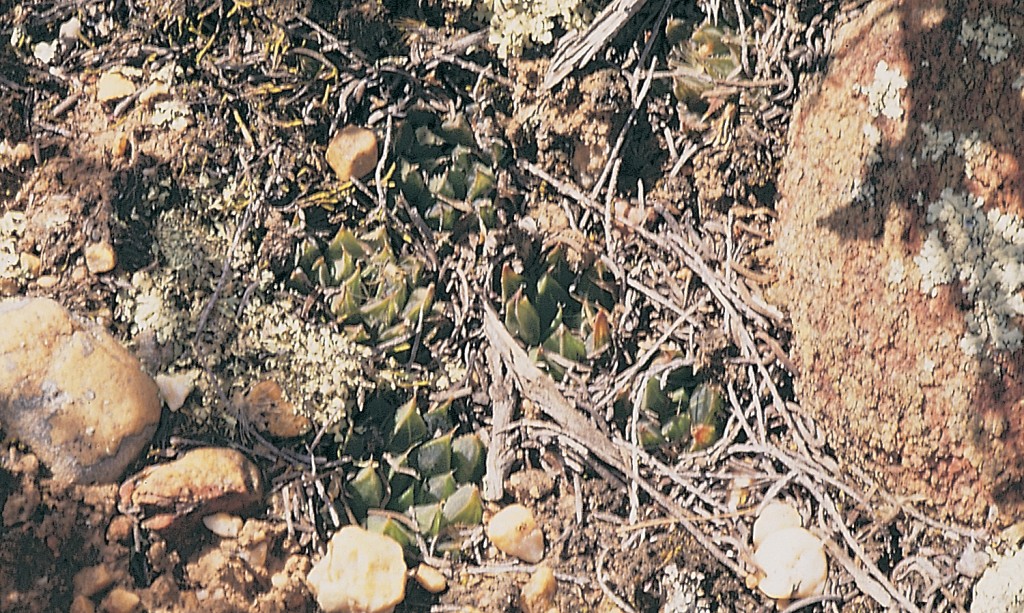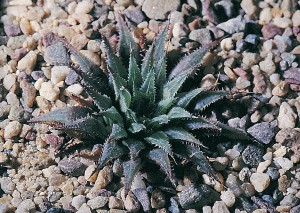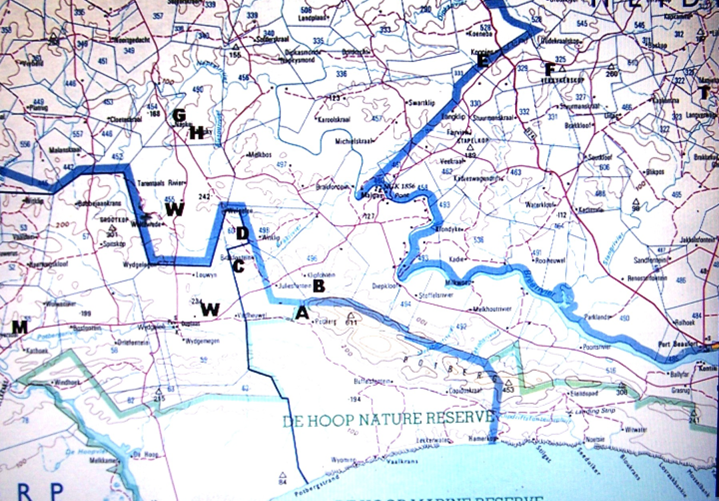14. Haworthia heidelbergensis Smith, JS.Afr.Bot. 14:42(1948). Bayer :121(1976). Bayer :41(1982). Scott :131(1985). Esterhuizen, Aloe 29:64(1992). idem. 33:15(1996). Type: CAPE‑3420 (Bredasdorp): W. Heidelberg (‑BB), J. Dekenah 230 in Smith 6566 (NBG).
heidelbergensis: from Heidelberg, Cape.
Rosette stemless, proliferous, to 8cm φ. Leaves many, erect to recurved, generally with small marginal and keel spines, usually dark green with reddish hues, end-area of leaf slightly translucent. Inflorescence simple. Flowers 10-15, white with brownish veins.
1982 – This is a small species occurring immediately east of Heidelberg. It grows deeply imbedded in moss and lichen and although the leaves have a distinct end area they are markedly acuminate. Known only from one locality, there is a related population at Matjestoon to the southwest in which the plants have longer recurving leaves, and another at Bredasdorp similar to the last. Together these three populations have no obvious affinities with any other species in the complex. Heidelberg is a very significant area for haworthias, as species such as H. turgida, H. magnifica, H. floribunda and H. retusa all occur nearby. H. heidelbergensis is not continuously variable with any of these. It is a winter‑growing species, invariably non‑proliferous and difficult in cultivation. The occurrence in moss and lichen suggests that it requires more shade than usual, as well as a distinct summer resting period.
1999 – This has proved to be the most surprising species among all the collections of the last ten years. Many collections have been made including at all the compass points immediately around Heidelberg, although those north are really considered hybrid with H. turgida. As Esterhuysen (1992) pointed out, the type locality is probably west of Heidelberg as recorded in Smith’s collecting records and on his type specimen. This is cited in the published description simply as ‘Swellendam District’. It extends further east towards Riversdale, westwards to Bonnievale and is common east and north of Bredasdorp. It has proved to be a major role player among the species in that area apart from its association with H. emelyae already dealt with. The populations around Heidelberg show evidence of direct introgression with H. turgida and cast new light on the relationship of that species with H. retusa. H. heidelbergensis is apparently the eastern counterpart of H. mirabilis and these two species never co-occur. H. serrata also cannot be excluded from discussion of this species (see H. serrata). At its westernmost limit at Bonnievale, it is confounded with H. maraisii var. meiringii. At the type locality it is rather atypical, an oxymoronic statement. Here the leaves are erect, but with a distinct end-area and there are not many leaves. Characteristic of the species is, however, the abundance of individuals at each site and their density in colonies usually on slightly southern slopes and in thick moss. The leaves may be smoothish and cloudily translucent or with translucence between veins on the upper leaf surfaces. The leaves tend to spread and recurve rather than being distinctly retused or with a swollen end-area as in the type. This is also one of the main feature separating H. mirabilis from H. maraisii, although it is by no means an absolute discriminant. The colour is also usually a reddish tinted greenish-brown. At Bredasdorp the population is greener than normal and the plants are like miniaturised H. mirabilis. Several varieties are distinguished to facilitate perception of this species.

a. var. heidelbergensis
Resende in Feddes Repert.Spec.Nov. 48:114(1940) suggested a change in the rules of nomenclature so that if a name proved not to be the true stem form (in other words not central to the circumscription of the species) the type should be changed for one that was. This is a case where that rule would prove quite useful. A manuscript concerning the pivotal role this species plays in the Southern Cape has been submitted to ALOE. Despite the major role this species plays in relation to all the species in the Southern Cape, not one of the illustrations in Bayer (1980), ‘The story of Haworthia nitidula’ depicts this. Larger plants occurs around Heidelberg and mid-way to Riversdale. The actual locality of the collection is rather odd, as Dekenah pointed out the locality to the author as east of the town, whereas there are two collection of Smiths received from Dekenah, one east and one west. They are virtually identical and Esterhuizen (1992) confirms this.
Distribution: 3420 (Bredasdorp): W. Heidelberg (‑BB), J. Dekenah 230 in Smith 6566 (NBG); E. Heidelberg (-BB), Smith 5756 (NBG), Bayer 2550 (NBG); Koppie opposite sports grounds (-BB), Smith 5044 (NBG); S. Heidelberg (-BB), Smith 6989 (NBG).
Inadequately located: Heidelberg, Joubert 180 (BOL).

Haworthia heidelbergensis var. heidelbergensis JDV93/54 G=Between Heidelberg and Riversdale. An extensive population where the plants are robust. 
Haworthia heidelbergensis var. heidelbergensis JDV87/1 east of Heidelberg. The upper leaf surfaces are always a little translucent. 
Haworthia heidelbergensis var. heidelbergensis JDV87/1 east of Heidelberg. Plants are smallish and grow in lichen and moss.
b. var. minor var.nov.
Type: CAPE-3420( Bredasdorp): Rooivlei (-CA), Bayer in KG 36/70 (NBG, Holo.).
minor: smaller.
Differs in being small, to 3cm φ, and in being light yellowish-green and well spined. (A var. heidelbergensis foliis parvioribus flavo-virentibus pallidis et spinosis differt).
North of Bredasdorp the plants resemble miniaturised forms of H. mirabilis var. sublineata and have the same plain green colour. The leaf-tips are also notably translucent.
Distribution: 3420 (Bredasdorp): Rooivlei (-CA), Bayer in KG 36/70 (NBG), Smith 3903 (NBG).

Haworthia heidelbergensis var. minor JDV86/5 north of Bredasdorp. Leaves narrower and smaller than the typical variety.
c. var. scabra var.nov.
Type: CAPE-3420 (Bredasdorp): Leeurivier (-AB), Bayer 1700 (NBG, Holo.).
scabra: rough.
Differs in being small, to 3cm φ and as tall. The colour is usually very dark green. The leaves erect or sub-erect, slightly scabrid especially along the margins and keel. (A var. heidelbergensis foliis recurvatioribus cum fenestra apicali distincta differt).
This is the commonest variety in terms of population distribution. The plants are quite small and very easily mistaken for erect-leaved forms of H. maraisii despite the general absence of ‘cloudy’ translucent windows in the leaves of the latter species. Although populations are often small, they are usually very dense.
Distribution: 3320 (Montagu): Drew (-CC), Fouche in PRE 34945; W. Bonnievale (-CC), Bayer 6509 (NBG), Lewis in NBG2457/33 (BOL). CAPE-3420 (Bredasdorp): Kliphoogte (-AA), Bayer 4677 (NBG); Leeurivier (-AB), Bayer 1700 (NBG); Brakfontein (-AC), Bayer 2547 (NBG); Beyersdal (-AD), Bayer 2556 (NBG); Haarwegskloof (-AD), Bayer 5101 (NBG); W. Kathoek (-AD), Bayer & Bruyns 6566 (NBG), Burgers 2581 (NBG); E. Kathoek (-AD), Bayer & Bruyns 6561 (NBG); N. Potberg (-BC), Bayer & Bruyns 6544 (NBG), Bayer & Bruyns 6545 (NBG).

Haworthia heidelbergensis var. scabra JDV86/3 north-west of Bredarsdorp. Occurs here in very dense clusters but very localized. 
Haworthia heidelbergensis var. scabra JDV92/85 north of Infanta. The leaves are shorter and broader than typical. 
Haworthia heidelbergensis var. scabra JDV87/4 east of Drew. Less translucent and the leaves are a little more rigid and scabrid than the other varieties. 
Haworthia heidelbergensis var. scabra JDV87/4 east of Drew. This population was severely damaged by cultivation and has survived only in a few remaining small ridges.
d. var. toonensis var.nov.
Type: CAPE-3420 (Bredasdorp): Matjestoon (-BB), Smith 6797 (NBG, Holo.).
toonensis: abbreviation for origin at Matjestoon.
Differs in the more recurved leaves with a distinct transparent end-area to the leaves.
Distribution: 3420 (Bredasdorp): Matjestoon (-BB), Smith 156, 6797 (NBG), Bayer 1698 (NBG).

Haworthia heidelbergensis var. stoonensis JDV87/3 Matjestoon. With longer softish leaves.

